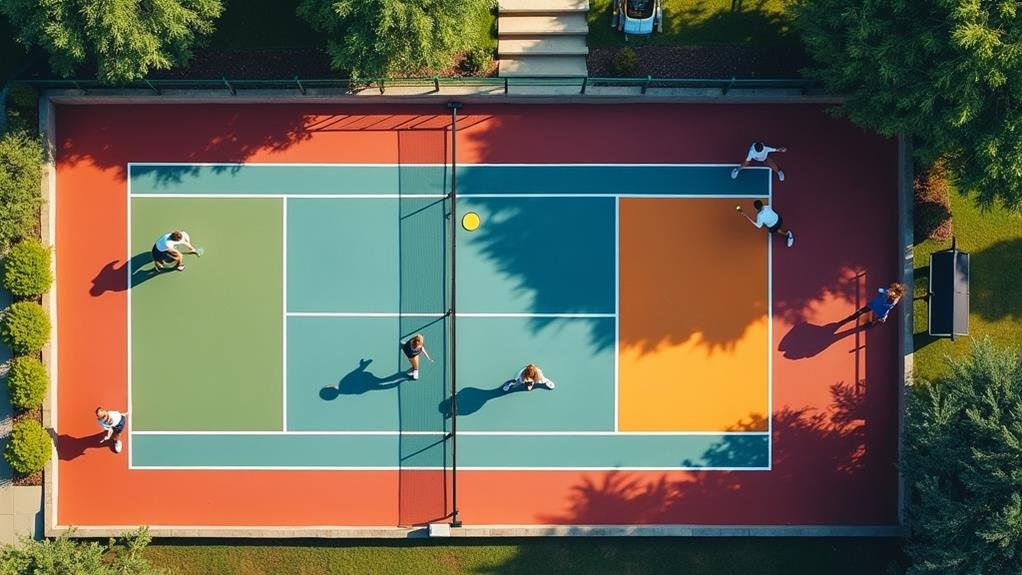A pickleball court is officially 20 feet wide and 44 feet long, making it perfect for both singles and doubles matches. The net sits at 36 inches high on the sides and drops to 34 inches in the center. You'll find a non-volley zone, or kitchen, extending 7 feet from the net, where you can't volley the ball. It's recommended to have a 5-foot buffer zone around the court to ensure safety. If you're curious about surface materials and setup tips, stick around for more insight into creating the perfect playing environment.
Key Takeaways
- A standard pickleball court measures 20 feet wide and 44 feet long for both singles and doubles play.
- The net height is 36 inches at the sidelines and 34 inches at the center for balanced gameplay.
- The non-volley zone (kitchen) extends 7 feet from the net, restricting players from volleying while standing inside it.
- A minimum buffer zone of 5 feet around the court is recommended to prevent collisions during play.
- Court markings include baselines, sidelines, and a non-volley zone line, typically painted in contrasting colors for visibility.
Overview of Pickleball Court Sizes
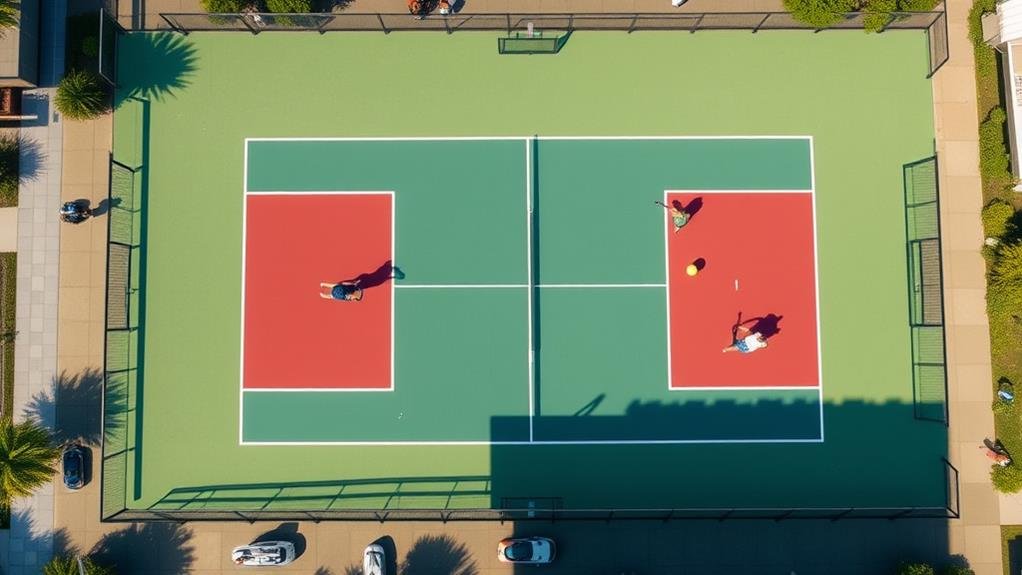
When you step onto a pickleball court, you'll notice that its dimensions play a crucial role in the game's dynamics. The court layout, typically a rectangle measuring 20 feet wide and 44 feet long for doubles play, creates a unique environment that influences how you approach the game.
Understanding the court size can help you refine your playing strategies, whether you're a beginner or an experienced player.
The net, positioned at 36 inches high at the sidelines and 34 inches in the center, further impacts your tactics. You'll need to consider how the height affects your shots and your opponents' responses.
The non-volley zone, or kitchen, adds another layer of complexity, requiring you to strategize around its 7-foot depth to avoid faults while trying to dominate the net.
As you develop your skills, mastering the court layout will enable you to make smarter decisions on shot placement and positioning.
This knowledge not only enhances your gameplay but also fosters a deeper appreciation for pickleball as a strategic sport.
Official Court Dimensions
Understanding the official dimensions of a pickleball court is vital for anyone looking to play the game correctly and competitively. A standard pickleball court measures 20 feet wide by 44 feet long for both singles and doubles play. The net height is set at 36 inches at the center, which promotes a balanced and challenging game.
In terms of court layout, the non-volley zone, or "kitchen," extends 7 feet from the net on both sides, ensuring that players have adequate space to maneuver while maintaining player safety. This designated area prevents aggressive volleys close to the net, reducing the risk of injury during intense rallies.
When designing or choosing a court, it's essential to ensure that there's ample clearance around the playing area. Ideally, a minimum buffer zone of 5 feet is recommended on all sides.
This space not only enhances gameplay but also keeps players safe from potential collisions or interruptions during matches.
Court Surface Materials
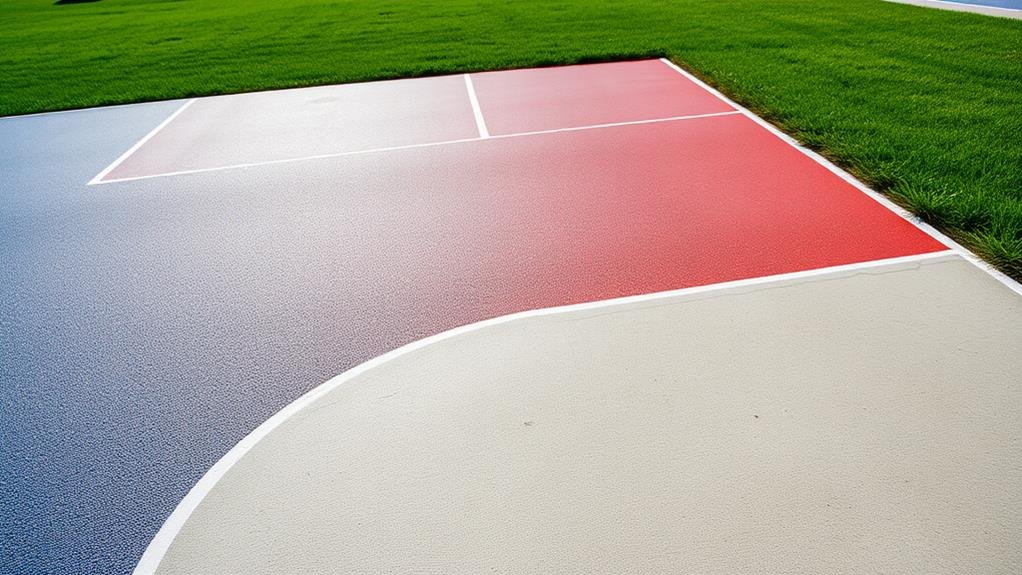
The right choice of court surface materials can significantly impact your pickleball experience. You'll find several court surface types, including asphalt, concrete, and specialized sports tiles, each offering unique benefits.
Asphalt is durable and cost-effective, providing a solid base for recreational play. Concrete, known for its longevity, requires careful installation to minimize cracks and ensure a smooth playing surface.
If you're looking for innovation, consider interlocking sports tiles. These modular surfaces offer excellent traction and shock absorption, reducing the risk of injury while enhancing gameplay. They're also customizable and easy to install, making them an appealing choice for both residential and commercial courts.
When selecting your surface, don't overlook surface maintenance. Regular upkeep is crucial to prolonging the life of your court. For asphalt and concrete, sealing cracks and cleaning debris will keep your surface in top shape. With sports tiles, occasional washing and reinstallation may be necessary.
Ultimately, the right court surface material not only elevates your playing experience but also supports your long-term enjoyment of the game. Choose wisely, and you'll create a pickleball environment that players will love!
Net Height and Specifications
Choosing the right court surface is just one part of creating an optimal pickleball environment; the net height and specifications play a significant role in gameplay dynamics. You'll want to ensure your net stands at 36 inches high at the sidelines and dips to 34 inches in the middle. This standard height is crucial for maintaining the flow and challenge of the game, allowing for strategic plays and volleys.
When it comes to net installation, attention to detail matters. Make sure the net is taut enough to avoid sagging, as proper net tension enhances the playing experience. An over-tightened net can lead to erratic ball bounces, while one that's too loose can dampen the excitement of quick exchanges.
To achieve optimal net tension, consider using adjustable tensioning systems or high-quality materials that withstand wear. Regular inspections and adjustments can ensure your net maintains its specifications over time, keeping your court performance at its peak.
Non-Volley Zone Details

When stepping onto a pickleball court, you'll quickly notice the importance of the non-volley zone, often called the "kitchen." This area, extending 7 feet from the net on both sides, restricts players from hitting the ball in the air while standing within it. The purpose of this zone is to encourage strategic play and prevent aggressive net attacks, which helps maintain a balance in the game.
Understanding the non-volley zone is crucial for effective player positioning. When you're near the kitchen, you need to be aware of your feet—if they cross the line while volleying, you'll lose the point. It's all about timing and positioning; you want to be ready to react but not too eager to strike.
When you approach the kitchen, consider using a drop shot to keep your opponent on the defensive. This tactic allows you to gain an advantage without violating the non-volley zone rule.
Mastering this area can elevate your game, as it forces opponents to rethink their strategies and creates opportunities for you to dominate at the net. Embrace the challenge of the kitchen, and watch your skills flourish!
Side and Baseline Measurements
While understanding court dimensions is essential for any pickleball player, the side and baseline measurements play a crucial role in your gameplay. Knowing these dimensions helps you strategize your shots and position yourself effectively during a match.
Here's a breakdown of the key measurements:
- Side Measurements: The total width of a pickleball court is 20 feet, which includes 10 feet of side space on either side of the court's centerline. This ensures you have enough room to maneuver and react to your opponent's shots.
- Baseline Dimensions: The baselines measure 44 feet long, running parallel to the net. These lines mark the boundary of the court, and staying within them is vital for maintaining your gameplay integrity.
- Service Area: Each side of the court features a service area that extends 15 feet from the net to the baseline. Understanding this area is crucial for executing your serves effectively.
Differences in Indoor Vs. Outdoor Courts
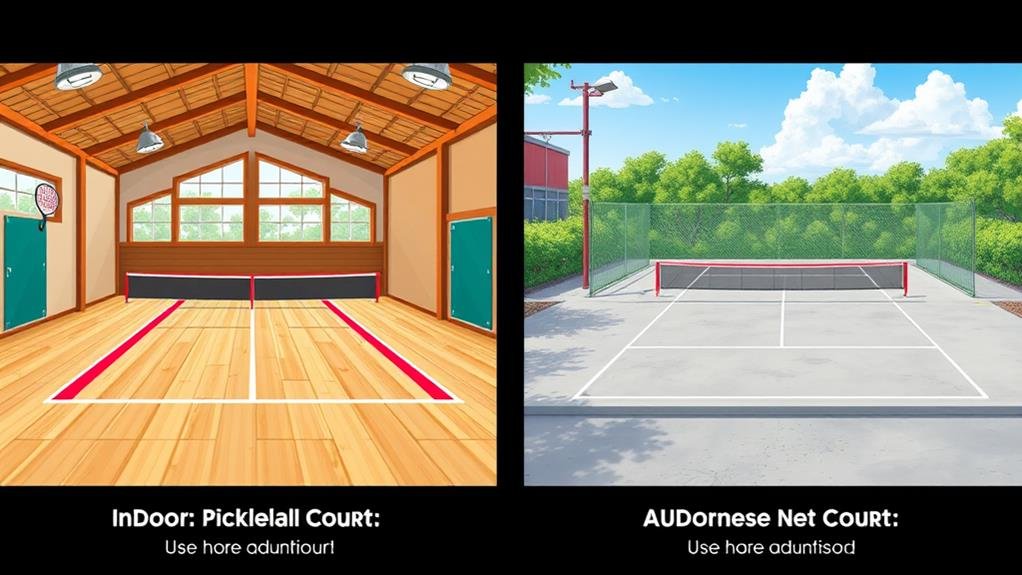
Understanding court dimensions lays the groundwork for effective gameplay, but the type of court—indoor or outdoor—can significantly affect your experience.
Indoor courts offer several advantages that can elevate your game. With controlled lighting and climate, you're less likely to be impacted by weather changes. This consistency allows for precise shots, letting you focus on strategy rather than external distractions.
On the flip side, outdoor courts present unique challenges. Factors like wind, sunlight, and varying surface textures can influence ball behavior and your overall performance. You might find that your shots require more adjustments, and mastering these elements can add an exciting layer to your gameplay.
Moreover, the social atmosphere often differs between indoor and outdoor venues. Indoor courts may feel more intimate, while outdoor courts can foster a lively, community-oriented vibe.
Ultimately, both environments offer distinct experiences that can enhance your pickleball journey. Whether you prefer the predictability of indoor play or the adventurous spirit of outdoor settings, understanding these differences can help you maximize your enjoyment and skill development in the game.
Court Markings and Lines
Court markings and lines play a crucial role in defining the playing area and ensuring fair play in pickleball. They not only guide players but also contribute to the overall court aesthetics.
Here's what you need to know about the essential markings:
- Baselines: These lines run parallel to the net and mark the outer boundaries of the court. They're crucial for determining whether a ball is in or out.
- Sidelines: These lines define the width of the court. The space between the sidelines and the net is where all the action happens, so their placement matters.
- Non-Volleyball Zone (NVZ) Line: Located 7 feet from the net, this line creates a critical area where players can't volley. Understanding this line is key to mastering your strategy.
When it comes to line colors, choosing contrasting shades enhances visibility and adds flair to the court.
Bright colors like blue or green can improve the overall look and feel of the playing area, making it more inviting.
Accessibility Considerations
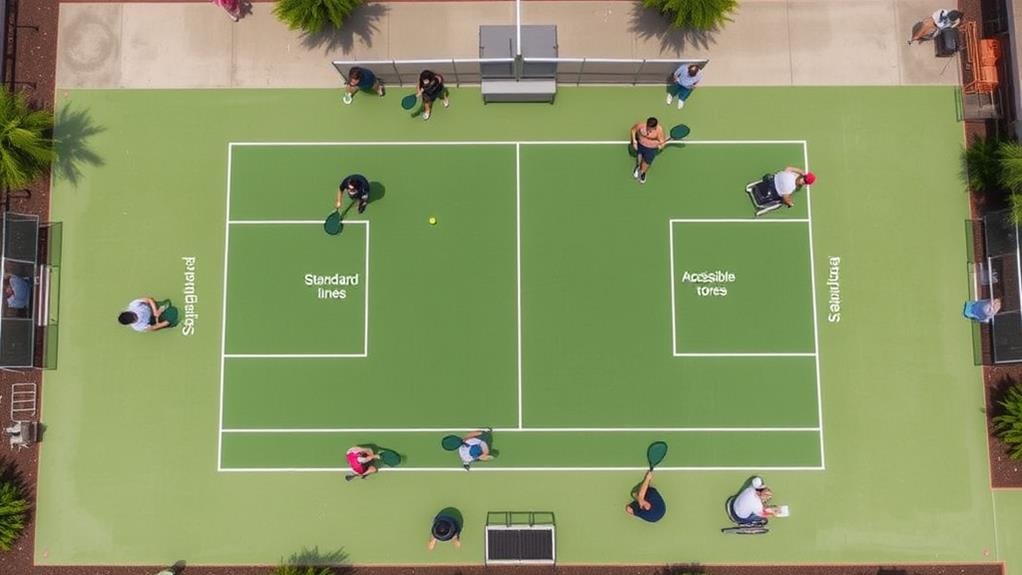
When designing a pickleball court, it's essential to consider accessibility for all players. Prioritizing wheelchair access is crucial, as it ensures that everyone, regardless of mobility challenges, can enjoy the game. Make sure to create smooth pathways leading to the court and ensure that the surface is even and free from obstacles.
Additionally, think about sensory accommodations to enhance the experience for players with sensory sensitivities. This might involve using contrasting colors for court markings or installing sound-dampening materials nearby to reduce overwhelming noise levels. Such innovations can make a significant difference in creating an inclusive atmosphere.
Consideration of accessibility also extends to seating arrangements. Providing designated areas for spectators, especially those requiring extra assistance, enhances the overall experience for everyone involved.
Moreover, ensure that lighting is adequate but not too harsh, allowing for a comfortable play environment.
Ultimately, integrating these accessibility features not only opens the door for more participants but also enriches the pickleball community. By fostering an inclusive environment, you promote a culture of acceptance and innovation that benefits all players.
Tips for Setting Up a Court
Setting up a pickleball court requires careful planning and attention to detail to ensure an enjoyable playing experience.
Whether you're designing a court for personal use or a community space, keep these tips in mind for optimal court layout and equipment placement:
1. Choose the Right Surface: Opt for materials like asphalt, concrete, or specialized sports flooring.
Ensure the surface is level and free from debris to enhance gameplay.
2. Plan the Court Dimensions: Stick to the official size of 20 feet wide by 44 feet long for doubles play.
Mark the lines clearly, ensuring they're at least 2 inches wide and painted in a contrasting color to the surface.
3. Position Equipment Wisely: Place nets at the correct height of 36 inches at the sidelines and 34 inches at the center.
Ensure that paddles, balls, and benches are easily accessible but don't interfere with gameplay.
Conclusion
Now that you know the ins and outs of pickleball court dimensions, you can better appreciate the game. Imagine stepping onto a perfectly marked court, the sun shining, and your friends gathered for a match. It's not just a game; it's a shared experience, a chance to connect and compete. Whether you're setting up a court at home or playing at a local center, these dimensions guide you to create memorable moments on the court. So grab your paddle and enjoy!

